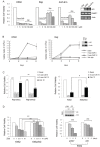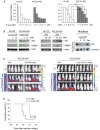AID downregulation is a novel function of the DNMT inhibitor 5-aza-deoxycytidine
- PMID: 24457556
- PMCID: PMC3960202
- DOI: 10.18632/oncotarget.1319
AID downregulation is a novel function of the DNMT inhibitor 5-aza-deoxycytidine
Abstract
Activation-induced cytidine deaminase (AID) was originally identified as an inducer of somatic hypermutation (SHM) and class switch recombination (CSR) in immunoglobulin genes. However, AID can also cause mutations in host genes and contribute to cancer progression and drug resistance. In this study, molecular docking showed the interaction of free 5-aza-CdR and Zebularine (Zeb) with AID. However, only 5-aza-CdR-incorporated ssDNA bound to the active site of AID and inhibited AID expression through proteasomal degradation. 5-aza-CdR demonstrated cytotoxicity against AID-positive and -negative hematopoietic cancer cells. In contrast, Zeb exhibited a cytotoxic effect only in AID-negative cells due to its inability to inhibit AID expression. This differential effect might be due to the DNMT1 stabilization induced by AID, thus restricting the ability of Zeb to deplete DNMT1 and induce tumor suppressor genes (TSGs), such as p21, in AID-positive cells. Moreover, the in vivo anticancer effect of 5-aza-CdR but not Zeb in AID-positive hematopoietic cancer cells was demonstrated. The study not only displays the association of AID and DNMT1 and identifies a novel biological function of AID, but also provides novel information regarding the use of DNMT inhibitors to treat AID-positive hematopoietic cancers.
Figures







Similar articles
-
5-Aza-deoxycytidine induces selective degradation of DNA methyltransferase 1 by a proteasomal pathway that requires the KEN box, bromo-adjacent homology domain, and nuclear localization signal.Mol Cell Biol. 2005 Jun;25(11):4727-41. doi: 10.1128/MCB.25.11.4727-4741.2005. Mol Cell Biol. 2005. Retraction in: Mol Cell Biol. 2022 May 19;42(5):e0054621. doi: 10.1128/mcb.00546-21. PMID: 15899874 Free PMC article. Retracted.
-
5-aza-2'-deoxycytidine-induced genome rearrangements are mediated by DNMT1.Oncogene. 2012 Dec 13;31(50):5172-9. doi: 10.1038/onc.2012.9. Epub 2012 Feb 20. Oncogene. 2012. PMID: 22349820 Free PMC article.
-
Effects of a novel DNA methyltransferase inhibitor zebularine on human breast cancer cells.Breast Cancer Res Treat. 2010 Apr;120(3):581-92. doi: 10.1007/s10549-009-0420-3. Epub 2009 May 21. Breast Cancer Res Treat. 2010. PMID: 19459041 Free PMC article.
-
Antineoplastic activity of the DNA methyltransferase inhibitor 5-aza-2'-deoxycytidine in anaplastic large cell lymphoma.Biochimie. 2012 Nov;94(11):2297-307. doi: 10.1016/j.biochi.2012.05.029. Epub 2012 Jun 9. Biochimie. 2012. PMID: 22687603 Free PMC article. Review.
-
Pharmacological approach for optimization of the dose schedule of 5-Aza-2'-deoxycytidine (Decitabine) for the therapy of leukemia.Leukemia. 1997 Mar;11 Suppl 1:S1-6. Leukemia. 1997. PMID: 9130684 Review.
Cited by
-
Digging deep into "dirty" drugs - modulation of the methylation machinery.Drug Metab Rev. 2015 May;47(2):252-79. doi: 10.3109/03602532.2014.995379. Epub 2015 Jan 8. Drug Metab Rev. 2015. PMID: 25566693 Free PMC article. Review.
-
Disease swamps molecular signatures of genetic-environmental associations to abiotic factors in Tasmanian devil (Sarcophilus harrisii) populations.Evolution. 2020 Jul;74(7):1392-1408. doi: 10.1111/evo.14023. Epub 2020 Jun 3. Evolution. 2020. PMID: 32445281 Free PMC article.
-
Upregulated Expression of Activation-Induced Cytidine Deaminase in Ocular Adnexal Marginal Zone Lymphoma with IgG4-Positive Cells.Int J Mol Sci. 2021 Apr 15;22(8):4083. doi: 10.3390/ijms22084083. Int J Mol Sci. 2021. PMID: 33920932 Free PMC article.
-
Prognostic impact of expression and methylation status of DENN/MADD domain-containing protein 2D in gastric cancer.Gastric Cancer. 2015 Apr;18(2):288-96. doi: 10.1007/s10120-014-0372-0. Epub 2014 Apr 3. Gastric Cancer. 2015. PMID: 24695972
-
Structure-Based Design of First-Generation Small Molecule Inhibitors Targeting the Catalytic Pockets of AID, APOBEC3A, and APOBEC3B.ACS Pharmacol Transl Sci. 2021 Jul 19;4(4):1390-1407. doi: 10.1021/acsptsci.1c00091. eCollection 2021 Aug 13. ACS Pharmacol Transl Sci. 2021. PMID: 34423273 Free PMC article.
References
-
- Perez-Duran P, de Yebenes VG, Ramiro AR. Oncogenic events triggered by AID the adverse effect of antibody diversifcation. Carcinogenesis. 2007;28(12):2427–2433. - PubMed
-
- Honjo T, Muramatsu M, Fagarasan S. AID: how does it aid antibody diversity? Immunity. 2004;20(6):659–668. - PubMed
-
- Kinoshita K, Nonaka T. The dark side of activation-induced cytidine deaminase: relationship with leukemia and beyond. International journal of hematology. 2006;83(3):201–207. - PubMed
-
- Takizawa M, Tolarova H, Li Z, Dubois W, Lim S, Callen E, Franco S, Mosaico M, Feigenbaum L, Alt FW, Nussenzweig A, Potter M, Casellas R. AID expression levels determine the extent of cMyc oncogenic translocations and the incidence of B cell tumor development. The Journal of experimental medicine. 2008;205(9):1949–1957. - PMC - PubMed
Publication types
MeSH terms
Substances
Grants and funding
LinkOut - more resources
Full Text Sources
Other Literature Sources

